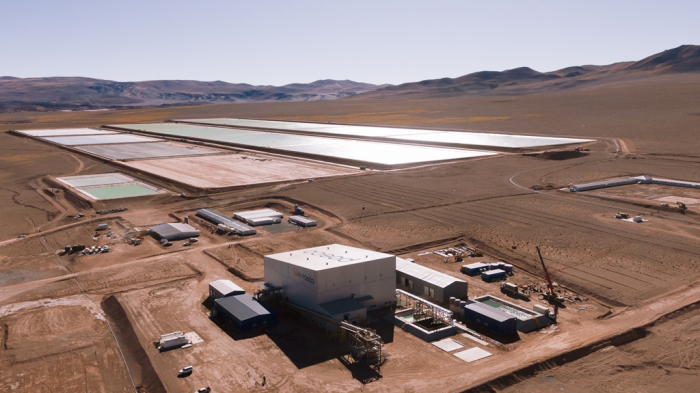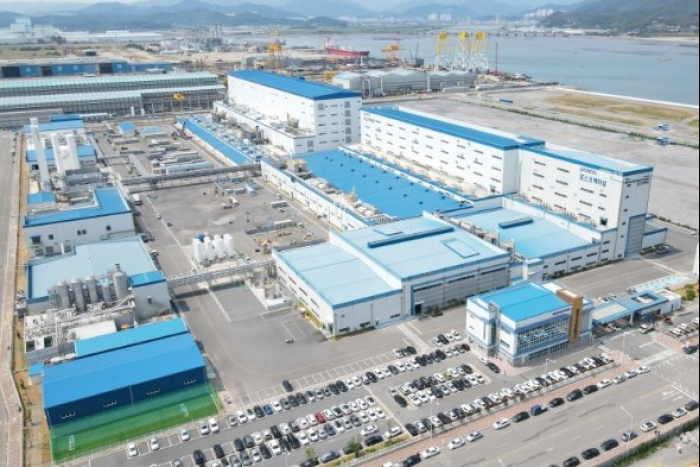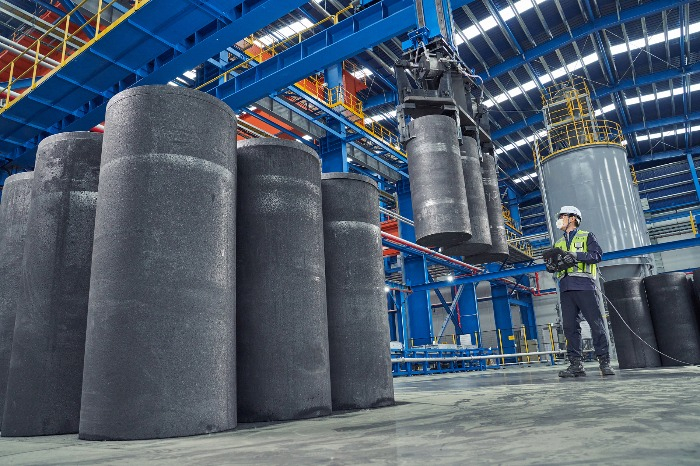POSCO sharply lifts 2030 battery materials sales targets
The steelmaker will begin commercial production of lithium later this year
By Jul 11, 2023 (Gmt+09:00)
LG Chem to sell water filter business to Glenwood PE for $692 million


Kyobo Life poised to buy Japan’s SBI Group-owned savings bank


KT&G eyes overseas M&A after rejecting activist fund's offer


StockX in merger talks with Naver’s online reseller Kream


Mirae Asset to be named Korea Post’s core real estate fund operator



South Korea’s POSCO Holdings Inc. on Tuesday sharply revised up its sales targets for rechargeable battery materials as it is aiming to join the ranks of the global top three secondary battery materials company by 2030.
With the increase in capacity growth, the steel giant jacked up the sales goal for battery materials by 51% to 62 trillion won ($48 billion) in 2030 in aggregate, compared with the 41 trillion won released in June of last year.
The previous 2030 target was twice as much as its 2026 sales projection.
POSCO plans to build the complete value chain for battery materials from metals such as lithium and nickel to cathodes, anodes and precursors, into which it will funnel about half of the 121 trillion won ($93.5 billion) investment planned by 2030.
LITHIUM
As a first step toward the goal, it will substantially ramp up its lithium processing capacity, POSCO said in its 2023 Value Day preared for analysts of the secondary battery materials business.
Lithium is a basic metal of precursors, one of the core materials of secondary batteries.
The holding company revised up the target for its 2030 lithium processing capacity growth by 40% from its earlier one.
The new capacity growth target of 423,000 tons is expected to translate into 13.6 trillion won in sales in 2023.

To achieve this goal, it will mine salt water lithium from the Hombre Muerto salt lake in Argentina it acquired in 2018.
POSCO plans to build a 100,000-ton lithium production capacity in Argentina by 2027, about one-fourth of the total capacity it targets to achieve by 2030 as a whole.
Additionally, it will advance into the market of clay-type lithium, a new-type metal.
NICKEL
To boost nickel output, POSCO will seek to partner with local metal processing companies in Indonesia and other countries for cost efficiency.
It will also develop the relevant technology there to cope with the US Inflation Reduction Act in favor of batteries, of which a certain portion of materials must be sourced in North America, or in the country of a trading partner.
The company aims to produce 240,000 tons of nickels a year by 2030. Combined, it will churn out 70,000 tons of lithium and nickel at its recycling plant in Gwangyang, South Korea.
The two types of metals will be supplied to POSCO Futures M. Co., a cathode producer, which will then produce 1 million ton of cathodes a year from the metals supplied by POSCO Holdings.

“From core metals to materials, we will build the full value chain (of the rechargeable battery materials) to achieve both quantitative and qualitive growth through capacity increase and high revenue, as well as through product portfolio diversity and technology development,” said Yoo Byung-ok, head of POSCO Holdings’ eco-friendly future materials business.
By 2030, it will expand the production capacity of high-purity nickel to 240,000 tons with 3.8 trillion won in sales; of cathodes to 1 million tons with sales of 36.2 trillion won; and of anodes to 370,000 tons with sales of 5.2 trillion won.
The capacity for recycled lithium, nickel and cobalt will grow to 70,000 tons, which will likely generate 2.2 trillion won in sales in 2030. The capacity for next-generation battery materials is projected to reach 9,400 tons by that year.
For next-generation materials, it is working on lithium metal anodes, or high-capacity anodes used in solid-state batteries.
POSCO will build its battery recycling bases in Europe and North America and supply them to customers in the regions.

CATHODES, ANODES, ELECTROLYTES
The steelmaker will introduce various types of cathode materials to better meet the needs of customers. Its cathode production facilities will be located mainly in South Korea.
For anodes, it will produce all types of anode materials made from either from natural and synthetic graphite, as well as from silicon.
For solid electrolytes, POSCO JK Solid Solution in 2022 completed a solid electrolyte plant to bump up its output.
This year, POSCO Group will start commercial production of lithium after POSCO HY Clean Metal built a lithium recycling plant. POSCO-Pilbara Lithium Solution is slated to complete a lithium hydroxide plant.
The group expects the commercial output of salt water lithium and nickel to generate profits for years to come, while perfecting the closed loop control system from raw materials to waste battery recycling.
A closed loop refers to an automatic control system, in which the output signal is fed back to the input of the system.
From July 12 to July 14, POSCO will host its Value Day event for analysts in Hong Kong and Singapore.
Write to Jae-Fu Kim at hu@hankyung.com
Yeonhee Kim edited this article
-
 SteelPOSCO gears up for big stride as green materials firm with Hyper NO
SteelPOSCO gears up for big stride as green materials firm with Hyper NOJul 06, 2023 (Gmt+09:00)
3 Min read -

-
 SteelPOSCO to spend $92 bn by 2030 to boost eco-friendly business
SteelPOSCO to spend $92 bn by 2030 to boost eco-friendly businessJul 03, 2023 (Gmt+09:00)
2 Min read -
 BatteriesPOSCO breaks ground on lithium hydroxide plant in S.Korea
BatteriesPOSCO breaks ground on lithium hydroxide plant in S.KoreaJun 13, 2023 (Gmt+09:00)
2 Min read -
 BatteriesPOSCO-GM JV to double cathode output, build precursor plant
BatteriesPOSCO-GM JV to double cathode output, build precursor plantJun 02, 2023 (Gmt+09:00)
3 Min read -
 BatteriesPOSCO Chemical breaks ground on second anode material plant
BatteriesPOSCO Chemical breaks ground on second anode material plantFeb 01, 2023 (Gmt+09:00)
1 Min read


